Who are riser recliner chairs suitable for?
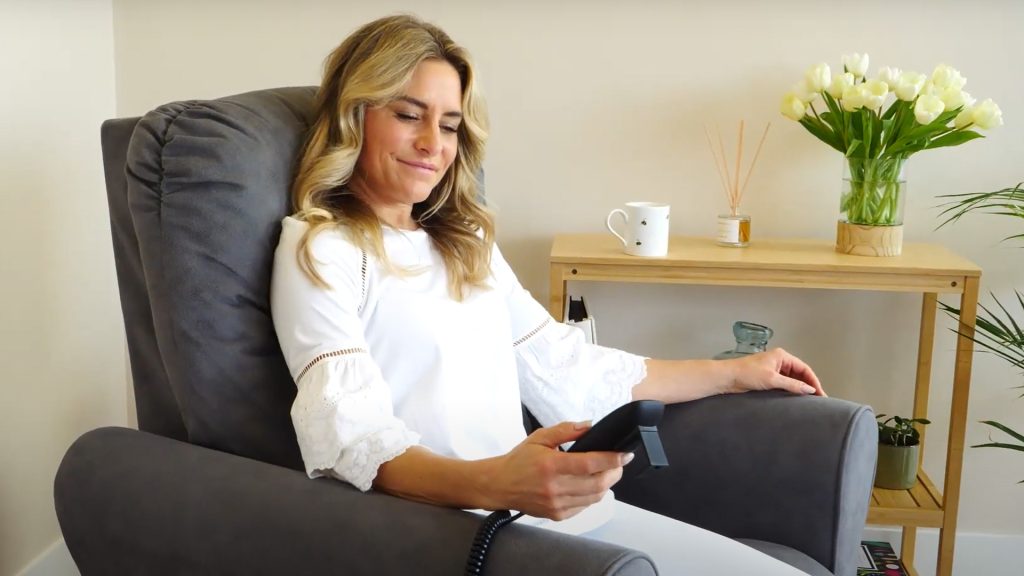
A riser recliner chair, also known as a “rise-and-recline chair” or “lift chair,” is an armchair designed to assist with sitting down and standing up. It resembles a comfortable recliner but incorporates an electric lifting mechanism.
At the push of a button, the seat gently tilts and rises forward to help you stand, or slowly lowers you into a seated position. Most models also feature a reclining backrest and an elevating footrest, allowing you to lean back and raise your feet with ease.
This combination of features makes riser recliner chairs popular among individuals who struggle to get in or out of a standard armchair independently. The chair essentially “lifts” to meet you, reducing the effort and strain required to stand up. The added support can enhance independence and safety at home for those with limited mobility or balance issues.
Many people also choose riser recliner chairs simply for comfort and improved posture. These chairs offer more ergonomic body support than a typical sofa, helping to prevent aches and pains caused by slouching.
Navigation guide
- Older adults and people with limited mobility
- Back pain relief and posture support
- Arthritis, sciatica and chronic pain
- Poor circulation and swollen legs
- Recovering from surgery or illness
- General comfort and relaxation
- Pressure relief cushions
- Full recline and neutral posture positions
- Built-in massage therapy
- Battery backup for safety
- Supportive armrests for grip
1. Who can benefit from a riser recliner chair?
Older adults and people with limited mobility
For many older adults or individuals with limited mobility, standing up from a low chair can be a challenge. Muscle weakness, balance issues, or conditions like knee arthritis can make the simple act of rising problematic.
A riser recliner chair directly addresses this by gently lifting you to a near-standing position, providing stability and reducing fall risk when standing.
The ability to get up safely at the touch of a button fosters greater independence in daily activities. You won’t need to wait for assistance to move around your home. For instance, you can easily rise to make a cup of tea without strain and then safely lower yourself back down to enjoy it.
Riser recliners often feature sturdy armrests, and some models include wooden grip handles, which you can hold onto during transfers. Healthcare professionals recommend chairs with armrests for those needing extra help to stand.
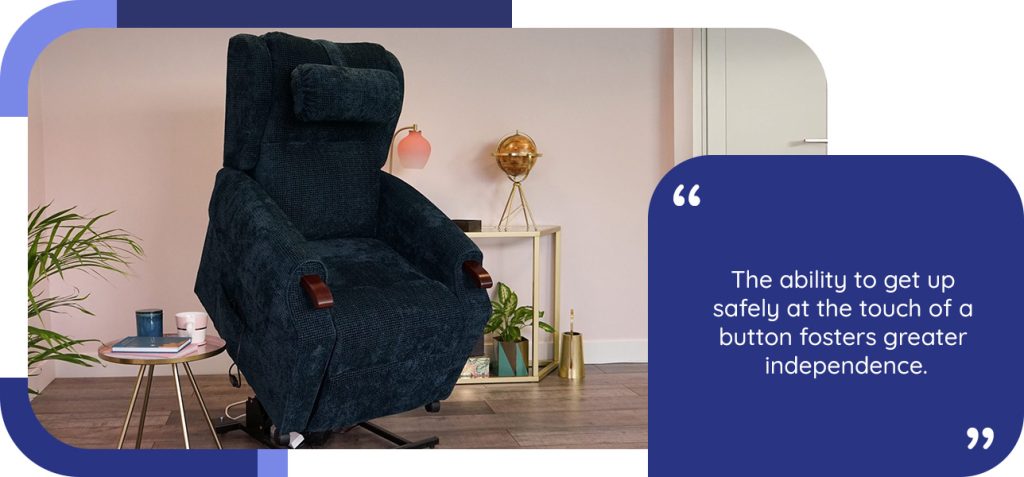
Back pain relief and posture support
Persistent back pain is a common issue often worsened by poor seating. If you suffer from a sore back or a spinal condition, a riser recliner chair can offer relief by promoting better posture and reducing strain.
Unlike a soft couch that might encourage slouching, a good riser recliner is contoured to support the natural curve of your spine. The chair’s design follows the “S” shape of the spine, supporting your lower back (lumbar region) and encouraging an upright sitting position. This helps minimise stress on your neck, shoulders, and back, which can alleviate discomfort over time.
Many riser recliners are also made or adjusted to fit your body measurements, ensuring proper lumbar support and seat height relative to your lower leg length. A chair tailored to your height and build is crucial for maintaining good posture; your feet should rest flat on the floor, and your back should be fully supported.
A custom-fitted chair provides even support along your spine, reducing muscle tension and easing back pain caused by unsupported sitting.
Another benefit for back pain sufferers is the ability to change positions easily. If prolonged sitting causes stiffness or pain, you can simply adjust the chair’s angle with a button press. This flexibility means you are not confined to a single position that might aggravate your back.
Medical advice often highlights that regular movement helps improve back pain. A riser recliner facilitates this safely, allowing you to tilt forward to stand more often or reposition frequently, preventing back stiffness.
Some advanced riser recliner chairs allow reclining into a “neutral spine” or “zero-gravity” position. In this sitting posture, the backrest and leg rest are balanced, often with feet elevated to heart level, distributing weight evenly. This position can relieve spinal pressure and decompress the lower back.
By reducing force on any single part of your back, a neutral recline can be very soothing for lower back pain or sciatica. It creates a sensation of floating, alleviating pressure on vertebrae. Even short periods in a zero-gravity position daily can help ease back pain flare-ups.
Arthritis, sciatica and chronic pain
Chronic pain often means that sitting in one position for too long can cause joints to stiffen or pain to worsen. Doctors and physiotherapists frequently recommend changing positions regularly to manage pain, which can be difficult if your chair is unaccommodating or standing up is painful.
A riser recliner makes position changes effortless. You can tilt, recline, or lift yourself as needed using the remote control, allowing you to shift weight and relieve pressure on painful areas whenever necessary. This prevents pain build-up in any single joint or muscle group throughout the day.
For example, if arthritis in your hips or knees aches after sitting, you can elevate your legs to reduce joint load or stand up more easily for a walking break. If sciatica is an issue, a slight recline or lumbar support adjustment can ease pressure on the sciatic nerve.
Standard riser recliners with a single motor offer good range of motion, while dual-motor models provide even greater flexibility with independent backrest and footrest control. The key benefit is that you remain in control of your comfort, avoiding being stuck in a static chair that might aggravate your condition.
Many riser recliner chairs also include built-in massage and heat functions, which can be a significant aid for chronic pain relief. Gentle vibration or heat can loosen tight muscles and soothe painful joints. For instance, Adjustamatic’s riser recliners offer an optional NHC Cyclo-Therapy® massage system, which uses a unique three-way rotating and pulsating motion to penetrate deep into muscles. This therapeutic massage can help relieve pain from arthritis, sciatica, and muscle spasms by promoting better circulation and relaxing muscle tension.
Poor circulation and swollen legs
If you experience poor circulation, leg swelling, or conditions like oedema, elevating your legs is often crucial for managing symptoms. Doctors frequently advise people with circulation issues to prop up their feet and avoid prolonged sitting with legs dangling.
A riser recliner chair simplifies this by including a built-in footrest that you can raise whenever desired. With a single click, you can lift your legs to at least hip level or higher. Elevating your legs above heart level helps blood and fluids flow back from your lower limbs, reducing swelling in your feet and ankles.
For individuals with circulatory disorders such as atherosclerosis or Raynaud’s phenomenon, maintaining warmth and encouraging blood flow is important. Many riser recliners come with integrated warming and massage features, like the vibration massage mentioned earlier. This gentle massage can stimulate blood circulation in your legs and feet, similar to a therapist’s touch.
Even without a massage feature, periodically raising and lowering your legs with the footrest can act as light exercise, helping pump blood through the veins.
Poor circulation often accompanies conditions like diabetes or post-stroke recovery. If you or a loved one is in this situation, a riser recliner chair is suitable as it enables at-home management of circulation needs. Instead of lying in bed to elevate your feet, you can remain in the living room and still comfortably elevate your legs in the chair. It encourages consistent leg elevation, which can help prevent complications like foot ulcers or blood clots from prolonged sitting.
Recovering from surgery or illness
Recovery periods, such as after major surgery, injury, or during an illness, often involve temporary mobility limitations. Riser recliner chairs can be incredibly useful in these situations, providing both comfort and crucial support.
For example, after hip replacement or knee surgery, bending and pushing yourself up from a low seat can be difficult for several weeks. Patients are often advised to use a firm chair with arms and avoid low seating during hip replacement recovery.
A riser recliner perfectly fits this need: it’s sturdy and padded for comfort, has supportive armrests, and most importantly, it will gently lift you to a standing position, preventing strain on healing joints. This allows you to follow therapy instructions (like short walks) more easily without risking injury or needing assistance each time.
If you are recovering from an illness causing weakness or fatigue (e.g., after a stroke, heart surgery, or a lengthy hospital stay), standing may be tiring. The riser recliner’s assistance means you expend less energy getting in and out of the chair, conserving your strength for other activities or prescribed exercises. It also lowers you slowly into sitting, which is gentler if you have surgical incisions or sore areas.
Another common scenario during recovery is sleeping in a chair. Perhaps it’s too difficult to get in and out of bed, or lying flat is uncomfortable due to a medical condition (some individuals with heart or respiratory issues prefer sleeping semi-reclined). While riser recliner chairs are not intended for long-term sleep, many models recline far enough for comfortable naps. They often have a near-flat full recline position where you can doze off in a supported posture.
If you or a loved one frequently sleeps in an armchair due to mobility issues, a riser recliner will ensure naps are taken in a posture that prevents new aches. (However, if consistent chair sleeping is necessary, an orthopaedic or adjustable bed might be considered for long-term sleep quality and safety).
During rehabilitation, small features of riser recliners also prove valuable. A battery backup means you can still get out of the chair during a power cut, which is reassuring if you are alone and recovering. Warmth and massage options can improve comfort and circulation, beneficial if you are less mobile.
General comfort and relaxation
If you’ve ever come home, sunk into a plush sofa for hours, and then felt a stiff or sore back, you’re not alone. Many standard armchairs and couches don’t provide optimal support, especially during extended sitting periods like movie marathons or long reading sessions.
By contrast, riser recliner sofas and chairs are engineered for comfort and support, even during long sitting sessions. They offer fully padded backrests, often with lumbar support and neck cushions, to maintain proper spinal alignment. The ability to recline allows you to find the perfect angle for relaxation, whether it’s a slight recline with feet up for watching TV or a deeper recline for a nap.
Because you can easily change the chair’s position, it’s great for restless sitters. You can sit upright for a crossword, then recline for TV, then raise your feet higher to read, all without moving chairs or piling pillows. This adaptability can prevent stiffness from staying in one static posture and simply feels luxurious to adjust your seating to your exact preference.
Comfort features like heating and massage can also enhance relaxation, even without a diagnosed health issue. Who wouldn’t enjoy a gentle back massage while unwinding in the evening? Additionally, as we age, even healthy individuals can develop minor aches from past injuries or general wear-and-tear. A riser recliner’s supportive design can help prevent these aches by promoting better posture.
Good posture isn’t just about avoiding back pain; it can also improve breathing and digestion. Slouching can cramp organs, while correct sitting aids deeper breathing and can help prevent acid reflux. Essentially, a riser recliner encourages a healthier way to relax; you are comfortable yet properly supported.
Finally, consider the sedentary lifestyle many of us lead. According to the British Heart Foundation, people aged 65 and above spend over 10 hours a day sitting or lying down. Even younger people working from home may find themselves seated for very long periods. If you’re going to be sitting for hours, investing in a chair that cares for your body makes sense.
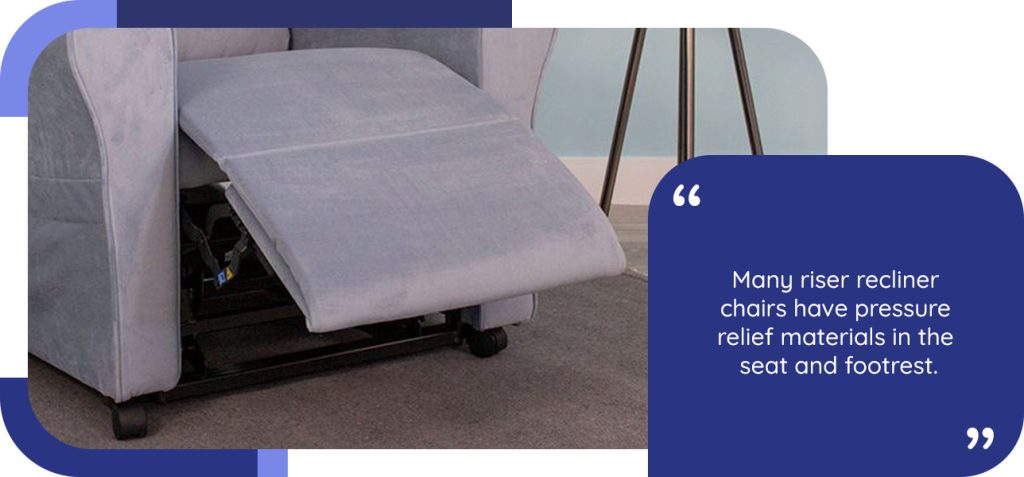
2. Key features of riser recliner chairs
Pressure relief cushions
If you spend a lot of time sitting, you’ll want your chair to relieve pressure on your body, especially at key points like the tailbone, hips, and heels. Many riser recliner chairs incorporate pressure relief materials in their seat and footrest to enhance comfort over long periods. Look for gel inserts or memory foam padding in the seat cushion.
Memory foam is particularly popular because it conforms to your body’s shape, distributing your weight more evenly. This prevents any single point (like your tailbone or thighs) from bearing too much pressure for too long. By moulding to your body, memory foam helps prevent the build-up of pressure points that can cause discomfort or numbness.
For individuals at risk of pressure sores or ulcers (e.g., those who are very frail or have limited mobility), these cushions are a necessity. Distributing pressure can help protect the skin and soft tissues.
Even without concerns about pressure ulcers, anyone will find that a pressure-relieving cushion makes sitting for hours much more pleasant, avoiding the burning ache from a hard seat. When shopping for a riser recliner, inquire about the seat’s foam or support. A high-quality chair will often highlight its pressure-relief design.
Also consider leg rest padding. The back of your legs (calves) rests on the footrest when elevated, so a nicely cushioned footrest will prevent strain on your calves and ankles. Some chairs also offer adjustable headrests or additional lumbar pillows, which can further customise pressure relief by targeting support where you need it most. For instance, an extra cushion behind your lower back for lordosis or a neck pillow for neck support.
Full recline and neutral posture positions
A major advantage of buying a riser recliner chair is that many models can recline much further than a standard armchair, with some even reclining nearly flat. This is a valuable feature if you like to nap in your chair or simply stretch out completely. When a chair has a full-recline option, it allows you to lie back as if on a bed (though with knees slightly bent over the footrest). While not generally recommended for all-night sleep, the ability to lie nearly flat means you can take a restorative nap in perfect comfort.
If you or a loved one occasionally sleeps in the chair due to difficulty moving to a bed, a full recline feature will make those naps much more comfortable. (As mentioned earlier, consider pairing it with an adjustable bed for long-term overnight sleeping).
Another concept is the “zero-gravity” or neutral posture position. This involves elevating your feet and reclining the backrest to distribute weight evenly, similar to how astronauts sit to reduce stress on their bodies. In a neutral posture, your body’s centre of gravity is balanced, and pressure on the spine, hips, and legs is minimised.
Many riser recliner chairs offer a preset neutral position due to its health benefits: it can promote better blood circulation, reduce swelling (as feet are elevated), and alleviate back pressure. People with back pain or joint pain often find the neutral position extremely comfortable for prolonged sitting. It’s also ideal for relaxing with a book or watching TV, as it relieves common pressure points from upright sitting.
To achieve a true neutral or zero-gravity posture, dual-motor chairs are typically used. A dual-motor riser recliner has one motor for the backrest and another for the footrest, allowing independent movement. This means you can, for example, raise your feet fully while only slightly reclining your back, or vice versa. Single-motor chairs, however, move the back and footrest together in a fixed ratio, offering less flexibility in positioning.
If specific positioning (like the feet-above-heart zero-gravity state) is important, you might opt for a dual-motor model. Adjustamatic’s Stirling riser recliner, for instance, includes a dual-motor design that allows fine-tuning recline and even full recline.
Finally, some chairs come with handy position presets – buttons that automatically move the chair into popular positions like “TV watching,” “reading,” or “sleep”. These presets can be convenient if you prefer not to adjust manually each time.
Built-in massage therapy
Riser recliner chairs often come with built-in massage therapy functions, a feature that can greatly enhance both comfort and health. While not all riser recliners have massage, many mid-range and premium models do (or offer it as an upgrade).
The type of massage system can vary: some use vibrating massage nodes in the backrest and seat; others (like Adjustamatic’s Cyclo-Therapy® system) use a more sophisticated rotational massage mechanism that creates a whirlpool-like motion through the chair. There are also chairs that offer air pressure massage, where airbags inflate and deflate to gently squeeze muscles.
The benefit of in-chair massage is enjoying a soothing treatment for sore muscles and joints without getting up. Sufferers of arthritis, back pain, fibromyalgia, or general muscle stiffness can find real relief from a 10- or 15-minute massage session in the chair. Massage can help increase blood flow, reduce muscle tension, and trigger the release of endorphins (the body’s natural painkillers). For example, if you have lower back pain, you could use the chair’s remote to target a massage to your lumbar area in the evening, perhaps combined with a heat function if available, to ease the ache before bed. If you have poor circulation or restless leg syndrome, a leg massage function might help by stimulating those areas.
Different chairs provide various massage modes and intensities. Some allow you to choose a gentle, continuous vibration versus a more vigorous pulsating massage. Others might have specific programs (like “wave” or “pulse” patterns).
Consider what would benefit you: a gentle massage can be very relaxing for general comfort, while a stronger, more targeted massage might be desired for deep muscle knots or pinched nerve pain. The Cyclo-Therapy feature is noted for its gentle but thorough action, creating a circular motion that penetrates without being harsh on the body.
Massage features typically operate on electricity, so they won’t work during a power cut unless your chair has a battery backup. They are generally safe and easy to use, but always follow manufacturer guidelines. For instance, avoid intense massage for extended periods, and individuals with certain medical devices or conditions (e.g., pacemakers, advanced osteoporosis) should consult a doctor.
Battery backup for safety
A practical but important feature to look for is whether the riser recliner chair has a battery backup system. This is a small battery that can temporarily power the chair’s motor in case of a power cut or electrical outage.
Why does this matter? Imagine being comfortably reclined or tilted back with your feet up when the electricity goes off. Without backup power, a powered chair would stop moving, potentially leaving you stuck in that reclined position. If you have limited mobility, getting out of a recliner stuck in a tilted-back state could be difficult or unsafe.
With a battery backup, the chair will have enough charge to return you to a neutral sitting position or even lift you to stand, despite the mains power being out. This ensures you’re not stranded in an awkward position. It’s primarily a safety feature, providing peace of mind even if rarely needed. For people who live alone or in areas prone to power cuts, this is especially valuable. Even in well-powered areas, accidents happen (tripped circuit breaker, accidental unplugging), so it’s a good insurance to have.
The battery backup might allow for a couple of full movements (e.g., one complete lift up and down cycle) when the power is out. It’s mainly for safely getting you out of the chair, not for regular off-grid operation. You might see it advertised as “Emergency battery backup”.
When shopping, ask if the model includes it or if it’s an add-on, as it might be optional on some chairs. Many modern riser recliners include it as standard.
If your chair has a battery backup, remember to check or replace the battery as recommended by the manufacturer. They usually last a long time but should not corrode or be dead when needed. Some systems are rechargeable, others use standard replaceable batteries; follow the manual’s guidance on maintenance.
Supportive armrests for grip
When standing up from any chair, people often press down on the armrests to help lift themselves. Riser recliner chairs already assist with lifting, but having a good armrest to hold onto provides extra stability and confidence, especially for those with weak legs or balance issues.
Many riser recliners offer firm armrest options or add-ons like wooden handles (sometimes called “knuckles”) at the arm ends. These are hard grips that you can wrap your hand around, which won’t compress under your weight. In contrast, a fully cushioned arm might feel soft and be harder to grasp firmly.
Solid wooden knuckle armrests provide a secure place to push off from when the chair is lifting you or when lowering yourself down. They can be very reassuring for people with arthritis in the hands or anyone who wants a better grip to prevent slipping.
Even without special handles, pay attention to the height and shape of the armrests. They should be at a comfortable height for you to rest your arms normally (too high and your shoulders will hike up; too low and you’ll slouch). When getting up, you should be able to naturally reach the armrests without bending over too far.
Most riser recliners are designed with this in mind, but if you are particularly short or tall, choose a chair size (petite, standard, grande, etc.) that ensures the armrest height suits you. Adjustamatic, for example, offers chairs in different size categories to match your stature.
If standing up is a challenge, also consider the width and padding of the arms – a wider armrest gives more surface area to lean on. Some users prefer a bit of padding but still a firm core in the armrest: this makes it comfortable under the forearm during normal sitting, but stable when pushing up. Many chairs strike this balance well.
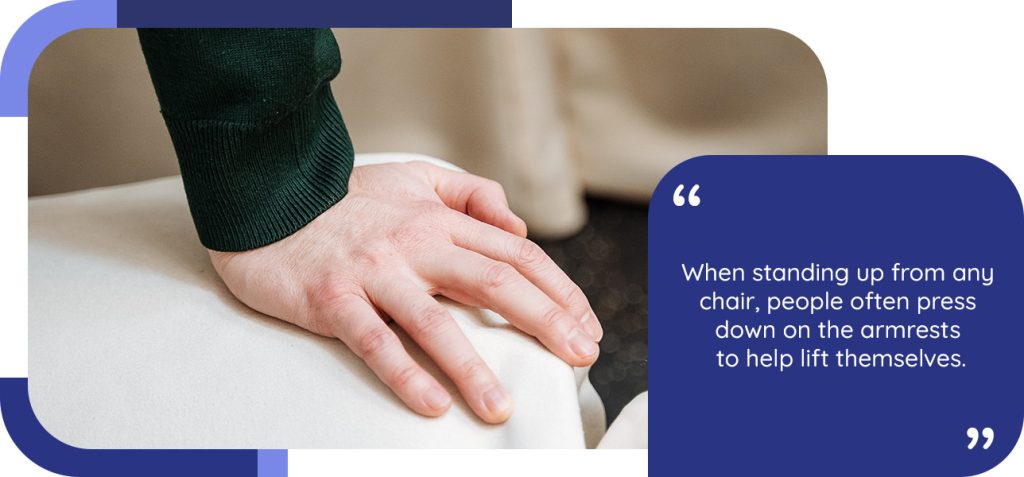
3. Take the first step toward greater independence and comfort
If you’ve recognised yourself or a loved one in any of the categories we’ve discussed, you’re already on the path to understanding how transformative the right riser recliner chair can be. The question now isn’t whether you could benefit from one – it’s finding the perfect chair that truly meets your individual needs.
Why Adjustamatic stands apart in riser recliner design
At Adjustamatic, we understand that choosing a riser recliner isn’t just about furniture – it’s about reclaiming your independence, managing your health conditions more effectively, and creating a sanctuary of comfort in your own home. That’s why every chair we craft reflects decades of British engineering excellence, built right here in our Welsh workshop.
What makes our approach to riser recliners unique:
- Precision-engineered for your body: Our chairs come in Petite, Standard, and Grande sizes, ensuring proper fit for optimal posture and pressure relief. Features like our supportive wooden knuckle armrests and memory foam cushioning are designed around real user needs, not generic specifications.
- Therapeutic innovation that works: Our exclusive NHC Cyclo-Therapy® massage system is a clinically-inspired solution for managing arthritis pain, improving circulation, and reducing muscle tension. Combined with our dual-motor systems and zero-gravity positioning, these chairs become genuine wellness tools.
- Safety and reliability you can trust: From our emergency battery backup systems to our smooth, quiet lifting mechanisms, every element is designed with your safety and peace of mind in mind. Our comprehensive warranties reflect our confidence in building chairs that will support you for years to come.
- Personal service that understands your journey: Our commitment doesn’t end when your chair is delivered. We provide comprehensive aftercare and support for the entire lifespan of your product, ensuring it continues to meet your needs for years to come. Our dedication to quality is why we can offer robust warranties that give you lasting peace of mind.
Experience the difference before you decide
The best way to know if a riser recliner is right for you is to experience it yourself. That’s why we offer complimentary home consultations where you can try our chairs in your own living space, ask questions about features that matter to your specific needs, and receive professional guidance on the best options for your circumstances.
Ready to explore how a riser recliner could enhance your daily life? Call us today free on 0800 689 9823 (lines open 9am-5pm Monday to Friday) or send us a message to book your free home consultation.
Invest in your daily comfort and independence—let Adjustamatic craft the perfect chair for you.
